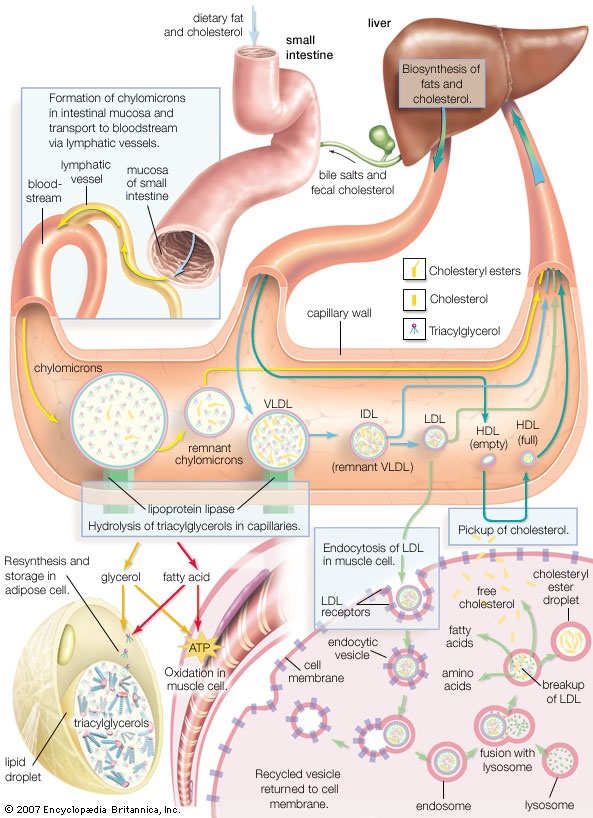familial hypercholesterolemia
medical disorder
 an inherited metabolic disease that is caused by deficiency of the LDL (low-density lipoprotein) receptor on the surface of cells (cell) in the liver and other organs. As a result, LDL cholesterol is not moved into the cells and thus remains in the blood, eventually accumulating in deposits on the walls of arteries (artery) ( atherosclerosis) and leading to cardiovascular disease or heart attack. Furthermore, under normal conditions, when enough cholesterol is present in a cell, feedback mechanisms signal enzymes (enzyme) to cease cholesterol synthesis. However, in familial hypercholesterolemia, these enzymes are relieved of feedback inhibition, thus inducing the production of excessive amounts of cholesterol. Symptoms of the disease include early coronary heart disease and angina pectoris (chest pain), atherosclerosis, and fatty deposits on the eyelids (eyelid) (xanthelasmas), the skin and tendons (tendon) (xanthomas), and around the cornea of the eye (eye, human) (corneal arcus).
an inherited metabolic disease that is caused by deficiency of the LDL (low-density lipoprotein) receptor on the surface of cells (cell) in the liver and other organs. As a result, LDL cholesterol is not moved into the cells and thus remains in the blood, eventually accumulating in deposits on the walls of arteries (artery) ( atherosclerosis) and leading to cardiovascular disease or heart attack. Furthermore, under normal conditions, when enough cholesterol is present in a cell, feedback mechanisms signal enzymes (enzyme) to cease cholesterol synthesis. However, in familial hypercholesterolemia, these enzymes are relieved of feedback inhibition, thus inducing the production of excessive amounts of cholesterol. Symptoms of the disease include early coronary heart disease and angina pectoris (chest pain), atherosclerosis, and fatty deposits on the eyelids (eyelid) (xanthelasmas), the skin and tendons (tendon) (xanthomas), and around the cornea of the eye (eye, human) (corneal arcus). Diagnosis is based on blood cholesterol levels, which are very high from birth in people with familial hypercholesterolemia; abnormally high LDL cholesterol levels are a common finding. Physical examination and heart function testing as well as family history and genetic testing can be used to make a definitive diagnosis. Familial hypercholesterolemia results from mutation of the LDLR (low-density lipoprotein receptor) gene. There are numerous different mutations in LDLR that can give rise to disease, including some that result in receptor dysfunction and others that result in decreased receptor production by cells. Familial hypercholesterolemia is autosomal dominant, meaning the inheritance of a single copy of the mutant gene from one parent is sufficient to cause disease. This form of inheritance results in a heterozygous genotype and is associated with the appearance of severe symptoms in the fourth or fifth decade of life. However, if a person with familial hypercholesterolemia is homozygous for the condition (inherits two copies of the mutant gene), severe vascular disease starts in early childhood, and heart attacks are usual by the age of 20.
Diagnosis is based on blood cholesterol levels, which are very high from birth in people with familial hypercholesterolemia; abnormally high LDL cholesterol levels are a common finding. Physical examination and heart function testing as well as family history and genetic testing can be used to make a definitive diagnosis. Familial hypercholesterolemia results from mutation of the LDLR (low-density lipoprotein receptor) gene. There are numerous different mutations in LDLR that can give rise to disease, including some that result in receptor dysfunction and others that result in decreased receptor production by cells. Familial hypercholesterolemia is autosomal dominant, meaning the inheritance of a single copy of the mutant gene from one parent is sufficient to cause disease. This form of inheritance results in a heterozygous genotype and is associated with the appearance of severe symptoms in the fourth or fifth decade of life. However, if a person with familial hypercholesterolemia is homozygous for the condition (inherits two copies of the mutant gene), severe vascular disease starts in early childhood, and heart attacks are usual by the age of 20.Treatment includes a low-fat diet, routine exercise, and drug therapy. Statins (statin), which inhibit an enzyme required for cholesterol synthesis, tend to be effective for reducing cholesterol levels. Other agents that may be used to lower cholesterol include fibrates, nicotinic acid, and bile acid sequestrants (resins).
- mouth fungus
- Mouton, Jean
- movable and immovable
- movable bridge
- Movement for the Fifth Republic
- movement perception
- Movement Toward Socialism
- Mowatt, Anna Cora
- Mowinckel, Johan Ludwig
- Mowinckel, Sigmund
- moxa treatment
- Mo Yan
- Moyen-Congo
- Moyle
- Moynihan, Berkeley George Andrew Moynihan, 1st Baron
- Moynihan, Daniel Patrick
- Moyobamba
- Moyshe Leyb Halpern
- Mozambique
- Mozambique Channel
- Mozambique Conventions
- Mozambique Current
- Mozambique, flag of
- Mozambique, Island of
- Mozarab